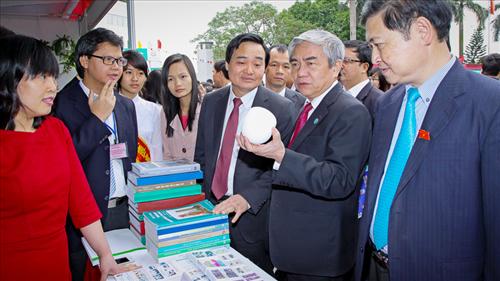

On the path to building and developing into a multi-disciplinary, multi-field research university on par with the continent, gradually reaching international standards, VNU always identifies science and technology activities as the foundation to improve the quality of scientific staff, improve the quality of training and increase competitiveness for the country's knowledge economy. Prof. Dr. Nguyen Huu Duc (Vice President of VNU) said: "Like other research universities in the world, basic research in the fields of social sciences and humanities, natural sciences, key technology and socio-economic sectors... is the strength of VNU and international publication has become a culture of quality".
After 20 years of construction and development, the number of international articles in the ISI system of VNU has increased 20 times (1993 - 10 articles/year, 2013 - nearly 200 articles/year), accounting for more than 12% of the total number of ISI articles in the country. Many articles have a high number of citations (from 50 to 500 times). These are important indicators to evaluate both the research level and the integration level of VNU. On this basis, since 2012, the QS international rankings have recognized and ranked VNU in the group of 250 (5%) of the top research universities in Asia.
Scientific research has contributed to improving the quality of training, especially doctoral training. In the fields of natural sciences (KHTN) and technology (CN), more than 50% of PhD students defending their theses have international articles. Scientific research has also created premises for the development of new training majors and disciplines, not yet included in the State's training list, creating unique and pioneering features of VNU such as majors in nanomaterials and components, climate change, sustainable science, etc.
In order to further promote the publication of research results to the world, according to the plan, from 2014, VNU will cooperate with Elsevier Publishing House (Netherlands) to publish the journal Vietnam Studies.
Determining that science must always aim to solve practical requirements of life, VNU develops synchronously and closely combines the fields of Natural Sciences and Social Sciences and Humanities, Science and Technology in interdisciplinary research. Basic research projects in the field of Social Sciences and Humanities have contributed to ensuring scientific arguments for the construction of strategic orientations, policies, guidelines, plans, and national development planning of the Party and State, and development planning of sectors and localities. Many programs, projects and scientific and technological topics have made practical contributions to the cause of national construction and defense, such as works on "Scientific arguments for history, geography and law of the Socialist Republic of Vietnam on the two archipelagos of Hoang Sa and Truong Sa", "The process of formation and development of the Southern region and the Southwest border"... Studies on the process of socio-economic structural transformation in the process of industrialization and modernization, gender equality, social equality... also contributed to providing a scientific basis for socio-economic policy making at the macro level, in which the Annual Report on Vietnam's economy has directly provided a scientific and practical basis for the process of making economic and social development policies of the Party... Currently, VNU is being assigned by the Government to preside over the Science and Technology Program for Sustainable Development of the Northwest region.
Research in the fields of natural sciences and technology is also oriented towards linking the development of products and scientific and technological solutions with practical service. During the period 2009-2013, scientists of VNU registered more than 10 patents.
At the large-scale exhibition and conference on commercialization of science and technology products of VNU, which was recently held on the occasion of the 20th anniversary of VNU, nearly 30 typical products and solutions for applying science and technology were introduced, dozens of consulting and technology transfer contracts were signed. These include the agreement with the People's Committee of Ha Nam province or the technology transfer contracts for the production of 3 types of DNA/RNA purification kits with ANABIO RESEARCH & DEVELOPMENT Joint Stock Company; biodiesel products to replace petroleum to reduce environmental pollution for Bai Tho Passenger Transport Company (Quang Ninh province); technology for selecting high-yield oil-bearing tree varieties suitable for barren lands with the Institute for Seed Improvement and Forestry Development (Agricultural Science and Technology Association); fireproof insulation foam brick products for Vietnam - China Refractory Materials and Electrical Construction Joint Stock Company; technology for preparing Enereffect - Plus film-coated tablets with high stability with Quang Binh Pharmaceutical Joint Stock Company; developing an IP camera system testing application for video signal encoding chip according to H.264/AVC standard with HANEL Specialized Electronics Joint Stock Company... The exhibition has left a deep impression on the audience, as Minister of Science and Technology Nguyen Quan expressed: this is a "rare" science and technology exhibition at universities. With the motto "science for humanity", VNU has made great efforts in commercializing science and technology products, creating connections between universities and businesses, bringing science and technology solutions and products into real life.
As a scientific research facility with the strongest potential in terms of scientific staff with 1,500 staff, including 349 professors, associate professors and 839 doctors of science and doctors, along with a relatively modern research facility system, including nearly 30 key laboratories creating conditions for the school's lecturers to research and innovate as well as for outside research facilities and enterprises to coordinate in scientific research, VNU deserves to be the "locomotive" of Vietnam's higher education.
Author:Duy Anh
Newer news
Older news